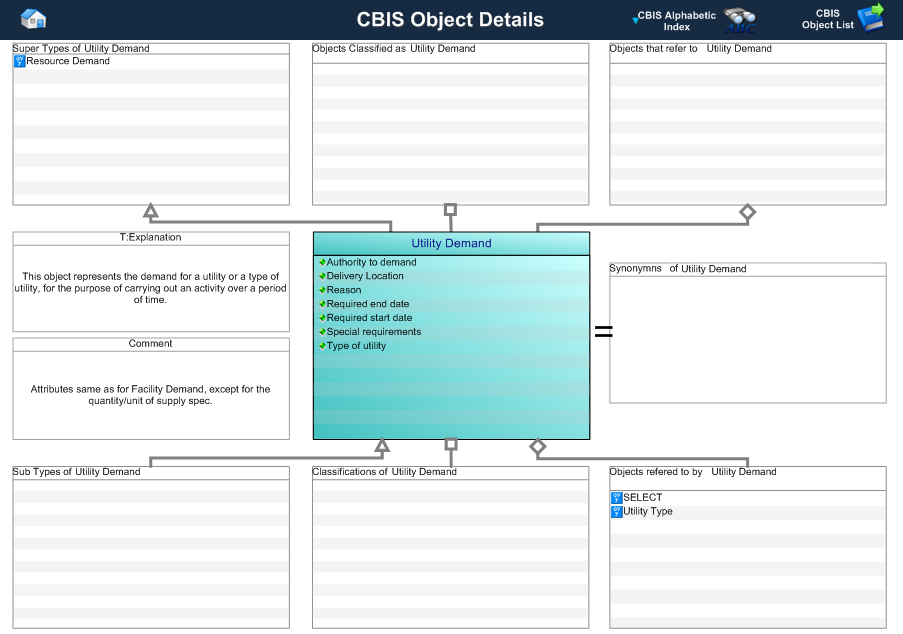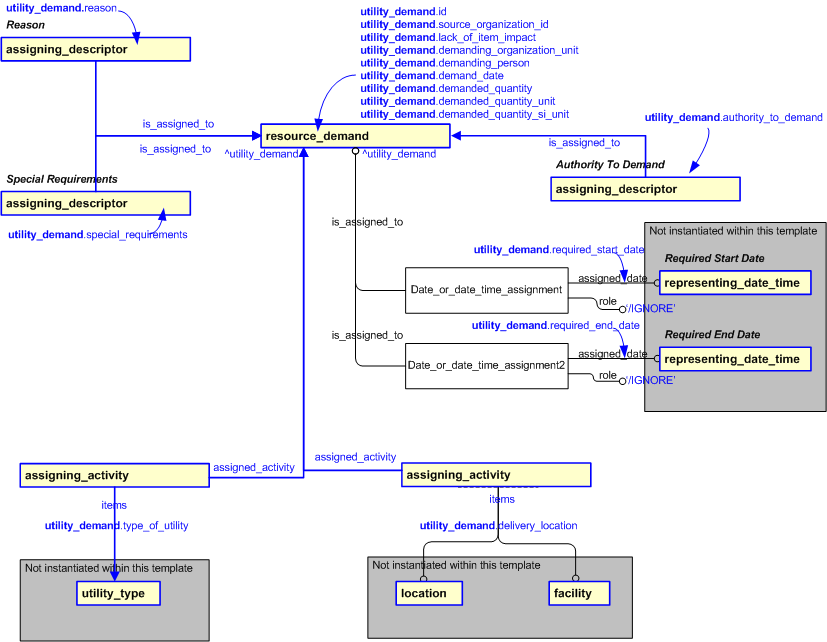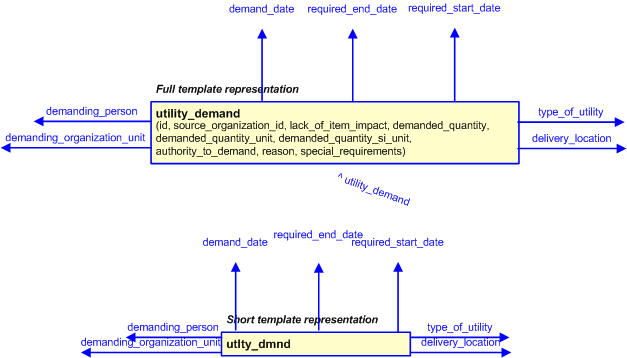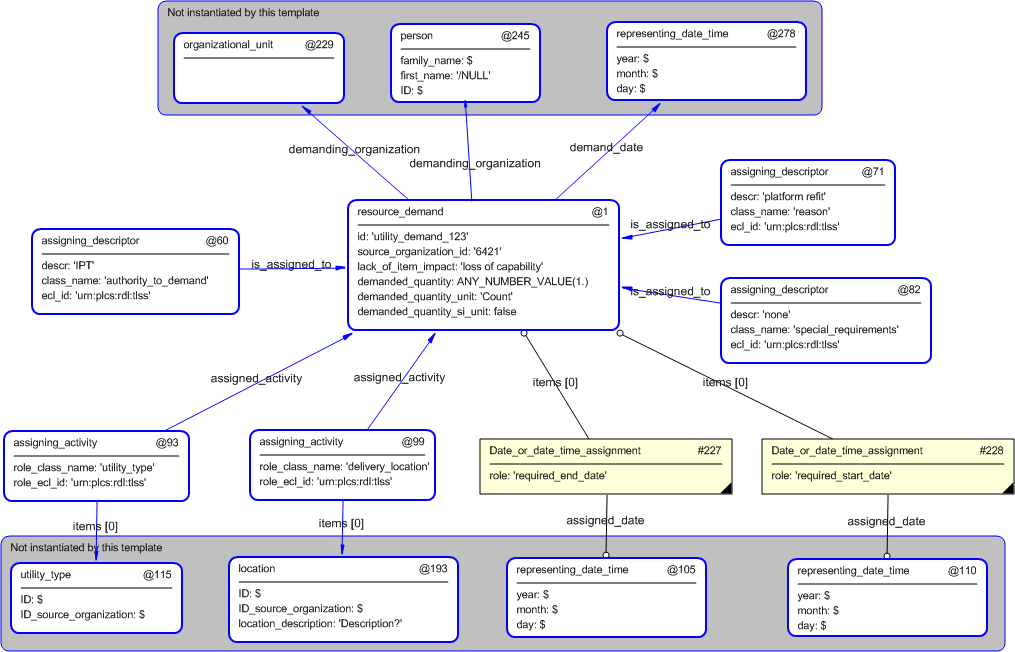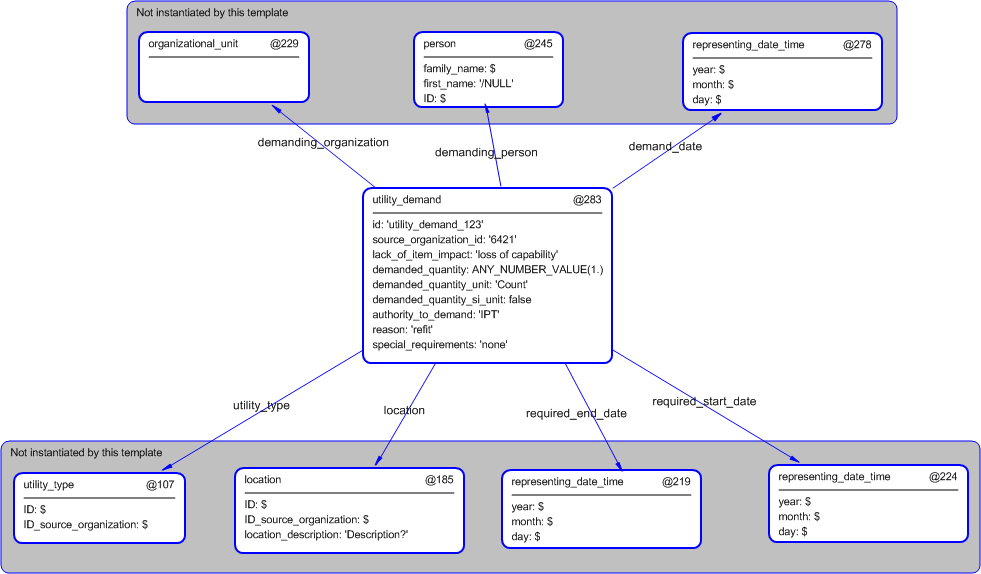Template:— utility_demand (utlty_dmnd)
Context:— UK_Defence |
Date: 2009/04/17 12:41:44
Revision: 1.5
|
This section specifies the template utility_demand.
NOTE
The template has been defined in the context of
UK_Defence.
Refer to the business context for details of related templates.
NOTE
An explanation of a template and the associated instantiation path is
provided in the
Template overview
section.
This template describes how to represent the demand for a utility or a type of utility, for the purpose of carrying out an
activity over a period of time.
The Support Solution Definition Resource Recommendation business object is used by those UK_Defence Data Exchange
Specifications that require information about the recommended resources required to support
the Platform, system and equipment for which the associated Support Solution Definition was
developed.
Figure 1 — Graphical Representation for Business Object Utility Demand
Utility Demand:
The definition of a Utility Demand object is:
This object represents the demand for a utility or a type of utility, for the purpose of carrying out an activity
over a period of time.
|
Attribute name
|
Attribute description
|
Attribute type
|
Optionality
|
| Authority to demand |
This is the authority to demand the related utility. |
intrinsic |
Mandatory |
| Delivery Location |
This is a reference to the location the utility is to be delivered or installed. |
Relationship to Facility or Location |
Mandatory |
| Reason |
This is a specification of the reason for the utility demand. |
intrinsic |
Mandatory |
| Required end date |
This is the end date of the period over which the utility is required. |
intrinsic |
Mandatory |
| Required start date |
This is the start date of the period over which the facility is required. |
intrinsic |
Mandatory |
| Special requirements |
This is for specifications of any special requirements. |
intrinsic |
Mandatory |
| Type of utility |
This is a reference to the type of utility being demanded. |
Relationship to Utility Type |
Mandatory |
Table 1 — Utility Demand attribute details
The EXPRESS-G diagram in
Figure
2
shows the templates and EXPRESS entities that are required
to represent the template
"utility_demand".
The text highlighted in blue shows the template parameters.
Figure 2 — An EXPRESS-G representation of the Information model for utility_demand
The graphic for the template to be used in other EXPRESS-G diagrams
is shown in Figure
3
below.
Figure 3 — The graphical representation of the utility_demand template
The following input parameters are defined for this template:
The identifier assigned to a requirement.
This is the description of the impact of the resource demand not being met.
The organization or unit demanding the resource.
The person making the resource demand.
This is the date the resource demand is made.
The quantity of the demanded resource.
The units of measure for the quantity of the demanded resource.
The following classes and their sub-classes can be used:
Value should be set to true if the unit is a SI base unit defined by ISO, i.e.
kilogram (kg) for Mass,
second (s) for Time,
metre (m) for Displacement,
ampere (A) for Electrical current,
kelvin (K) for Temperature,
mole (mol) for Amount of substance, and
candela (cd) for Luminous intensity. If this is not the case it should be set to false.
Note that the representation of true and false depends on exchange format. In Part 11 (a STEP file) true is
represented by the string ".T.", and false by ".F.", while in Part 28 (XML) they are represented by text strings
"true"
and "false".
This is the authority to demand the related utility.
This is a reference to the location the utility is to be delivered or installed.
This is a specification of the reason for the utility demand.
This is the end date of the period over which the utility is required.
This is the start date of the period over which the utility is required.
This is for specifications of any special requirements.
This is a reference to the type of utility being demanded.
The following reference parameters are defined for this template:
Allow the
Activity
entity instantiated in this path to be referenced when this template is used.
Note: The
Activity
entity can be referenced in a template path by:
%^target = $utility_demand.utility_demand%
where
target
is the parameter to which the
Activity
is bound.
The instantiation path shown below specifies the entities that are to be
instantiated by the template.
A description of templates and the syntax for the instantiation path is
provided in the
Templates Help/Information section.
-- Utility demand is based upon resource demand /
resource_demand(
id=@id,
source_organization_id=@source_organization_id,
lack_of_item_impact=@lack_of_item_impact,
demanding_organization_unit=@demanding_organization_unit,
demanding_person=@demanding_person,
demand_date=@demand_date,
demanded_quantity=@demanded_quantity,
demanded_quantity_unit=@demanded_quantity_unit,
demanded_quantity_si_unit=@demanded_quantity_si_unit)/
%^utility_demand = $resource_demand.resource_demand%
-- authority_to_demand /
assigning_descriptor(
descr=@authority_to_demand,
class_name='Authority_to_demand',
ecl_id='urn:plcs:rdl:uk_defence',
is_assigned_to=^utility_demand)/
-- reason /
assigning_descriptor(
descr=@reason,
class_name='Reason',
ecl_id='urn:plcs:rdl:uk_defence',
is_assigned_to=^utility_demand)/
-- special_requirements /
assigning_descriptor(
descr=@special_requirements,
class_name='Special_requirements',
ecl_id='urn:plcs:rdl:uk_defence',
is_assigned_to=^utility_demand)/
-- Required_start_date Date_or_date_time_assignmentDate_or_date_time_assignment.role = '/IGNORE'
Date_or_date_time_assignment.items ->
^utility_demand
Date_or_date_time_assignment.assigned_date ->
@required_start_date-- Required_end_date Date_or_date_time_assignmentDate_or_date_time_assignment.role = '/IGNORE'
Date_or_date_time_assignment.items ->
^utility_demand
Date_or_date_time_assignment.assigned_date ->
@required_end_date-- delivery location /
assigning_activity(
role_class_name='Delivery_location',
role_ecl_id='urn:plcs:rdl:uk_defence',
assigned_activity=^utility_demand,
items=@delivery_location)/
-- type of utility /
assigning_activity(
role_class_name='Type_of_utility',
role_ecl_id='urn:plcs:rdl:uk_defence',
assigned_activity=^utility_demand,
items=@type_of_utility)/
The following entities are instantiated with attributes as specified:
The instance diagram in Figure
4
shows an example of the EXPRESS entities and templates that are instantiated by the template:
/utility_demand(demand_date='@278', demanded_quantity='1', demanding_organization='@229', demanding_person='@245', id='utility_demand_123', source_organization='6421', lack_of_item_impact='loss of capability', authority_to_demand='IPT', delivery_location='@193', reason='refit', required_end_date='@105', required_start_date='@110', special_requirements='none', type_of_utility='@115')/
(an illustration of the consolidated utility_demand template is shown in
Figure
5 below.)
Figure 4 — Entities instantiated by utility_demand template
The instance diagram in
Figure
5
shows the graphic symbol for the template that is to be
used in other instance diagrams. The example template is:
/utility_demand(demand_date='@278', demanded_quantity='1', demanding_organization='@229', demanding_person='@245', id='utility_demand_123', source_organization='6421', lack_of_item_impact='loss of capability', authority_to_demand='IPT', delivery_location='@193', reason='refit', required_end_date='@105', required_start_date='@110', special_requirements='none', type_of_utility='@115')/
Figure 5 — Instantiation of utility_demand template
Characterizations
No common characterizations of the template
utility_demand
have been identified. However, the ISO 10303-239 EXPRESS model
may enable other assignments to the entities instantiated by the template.
